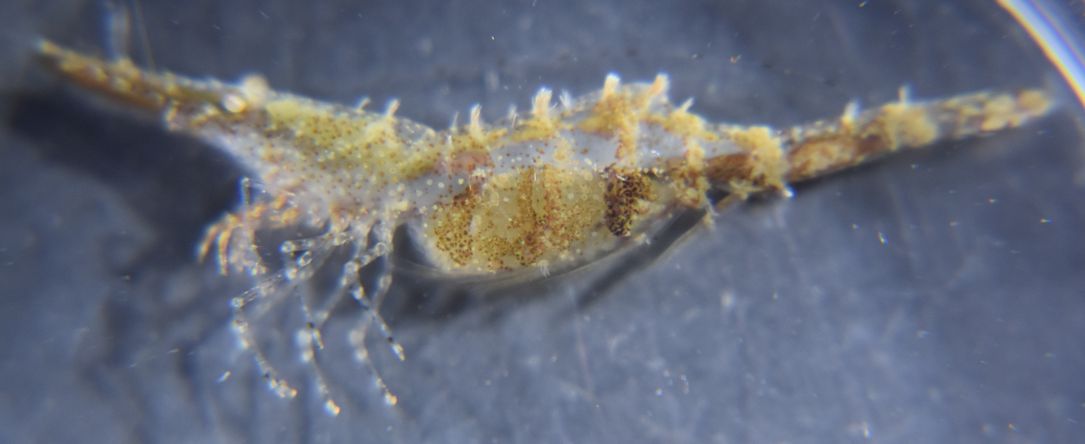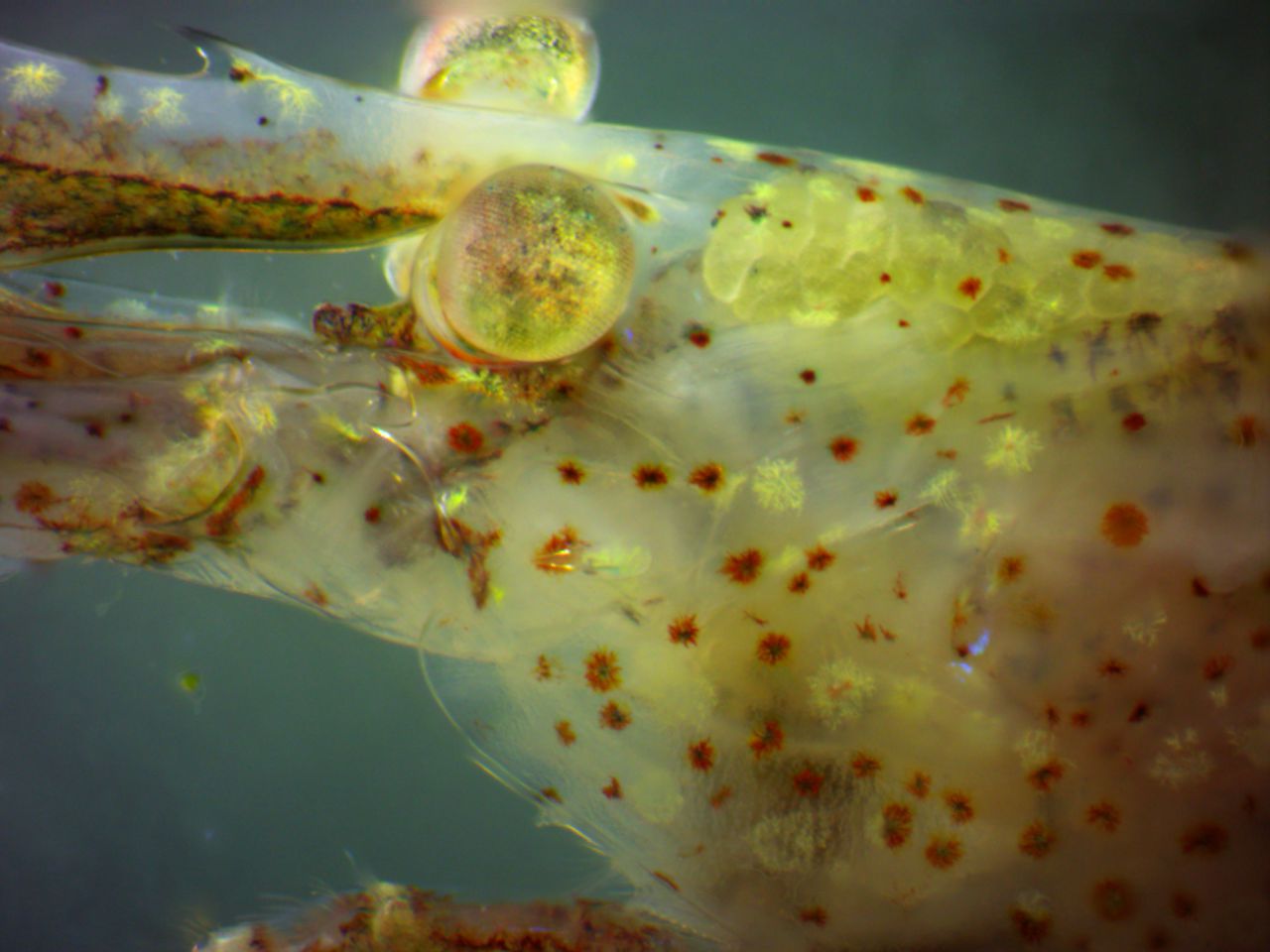Hippolyte clarki Chace, 1951Common name(s): Grass shrimp, Green shrimp, Little green shrimp, Kelp humpback shrimp |
|
| Synonyms: |  |
|
Phylum Arthropoda
Subphylum Crustacea
Class Malacostraca
Subclass
Eumalacostraca
Superorder Eucarida
Order Decapoda
Suborder Pleocyemata
|
|
| Hippolyte clarki found on subtidal eelgrass in Padilla Bay. Carapace length is 5 mm, total length (including rostrum) is 2.8 cm. | |
| (Photo by: Dave Cowles, August 2018) | |
Description: As with other members of Family Hippolytidae, the rostrum is toothed and laterally compressed. The first pereopod is chelate (not subchelate), and shorter but thicker than the other pereopods. The second pereopod is also chelate (photo), more slender, and with a multiarticulated carpus (photo). Hippolytidae is the largest family of shrimp here in the North Pacific ocean, but the individuals tend to be fairly small in size. Members of genus Hippolyte have the carpus of the second pereopod subdivided (multiarticulated) into 3 segments (photo) (other members of the family have 7 segments). They have a conspicuous rostrum with teeth (photo). The carapace has a supraorbital and a branchiostegal spine (photo). The telson has 2 pairs of dorsolateral spines (photo). The males are much smaller than females, have a shorter rostrum, and thinner pereopods. Most species live on littoral vegetation or on floating seaweed. This species is a small shrimp with a rostrum that ascends slightly and ends in three points (photo) (some references say two). The rostrum of the female is 1.2 to 1.4x carapace length, while in the male it is only about 0.8 to 1.1x carapace length. The shrimp is usually colored a fairly uniform bright green (sometimes, as here, with blue spots) and blends in well with eelgrass. Some individuals may be brown or reddish (see photos). Total length of female to 3.1 cm, male to 1.8 cm.
How to Distinguish from Similar Species: Other genera in Family Hippolytidae, such as Spirontocaris, Lebbeus, and Heptacarpus, all have 7 segments in their multiarticulated carpus of the 2nd pereopod. The bright green color is generally distinctive. Hippolyte californiensis, which older references state is only found from Central California south but some newer references state it can be found as far north as Alaska, is often very similar to this species but has 1-2 teeth on the distal end of the first segment of the first antennae and it has only 2 teeth on the end of its rostrum ('bifid tip', some references state it has 3 teeth). See the photographs and notes below about H. californiensis.
Geographical Range: Sheep Bay, Alaska to Isla Cedros, Baja California.
Depth Range: Intertidal to 30 m
Habitat: Common in eelgrass beds, especially in the northern parts of its range. May live on Nereocystis or Macrocystis kelp as well.
Biology/Natural
History: This species
eats mainly algae and small crustaceans. It is an important food item
for
juvenile rockfish when living in kelp. The parasitic isopod Bopyrina
striata may live in the gill chamber of members of this
genus.
| Return to: | |||
| Main Page | Alphabetic Index | Systematic Index | Glossary |
References:
Dichotomous Keys:Carlton, 2007
Kozloff, 1987, 1996
Wicksten, 2009
General References:
Butler,
1980
Jensen,
1995
Jensen,
2014
Lamb
and Hanby, 2005
Morris
et al., 1980
Scientific Articles:
Web sites:
General Notes and Observations: Locations, abundances, unusual behaviors:
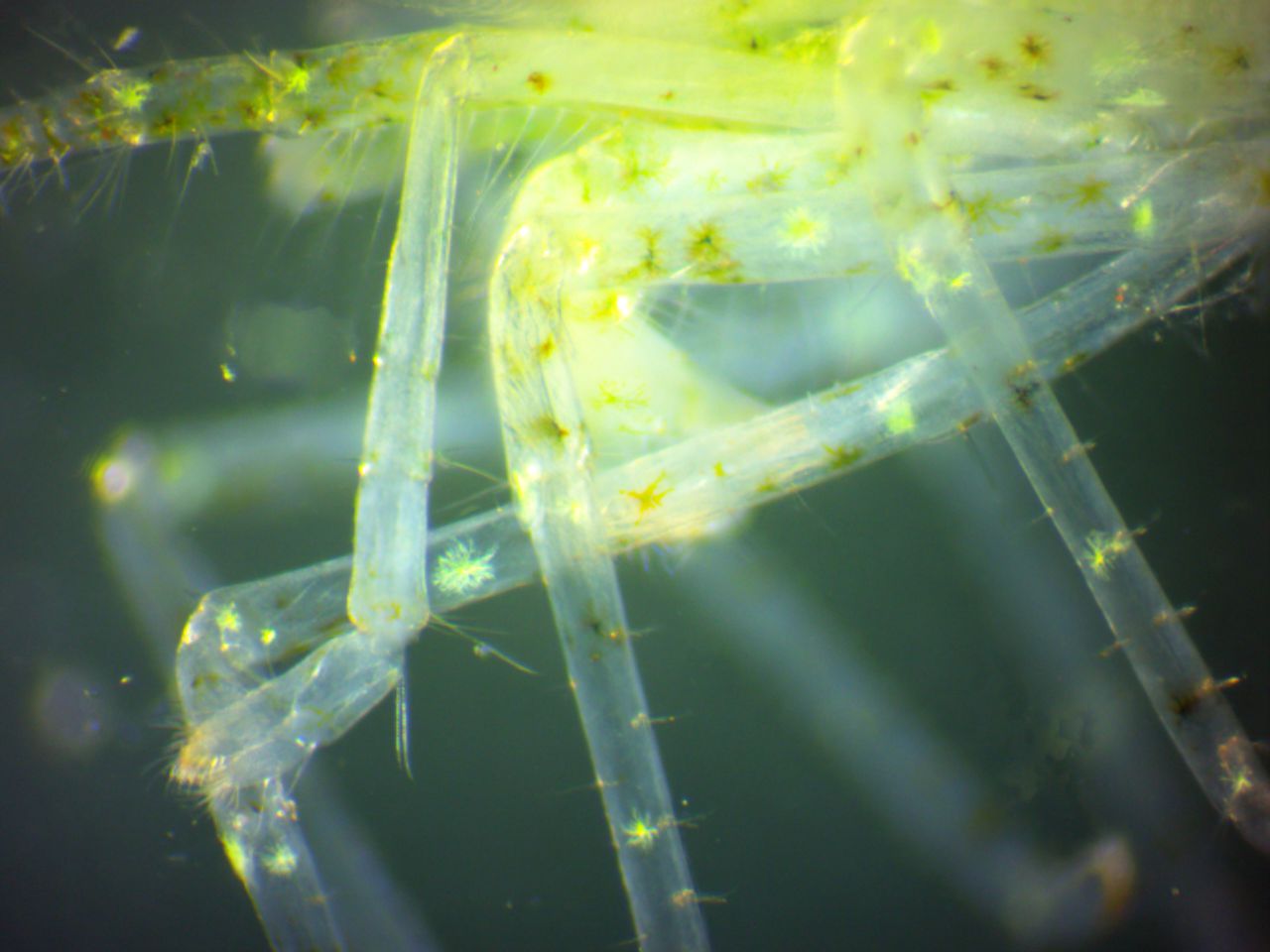
In genus Hippolyte the carpus
of pereopod
2 is multiarticulated into three segments. In this view the main
descending
leg segments, from left to right, are the carpus
of pereopods 2, 3, and 4. The three sections of the carpus
of pereopod
2 can be clearly seen, as well as the fact that the leg is chelate.
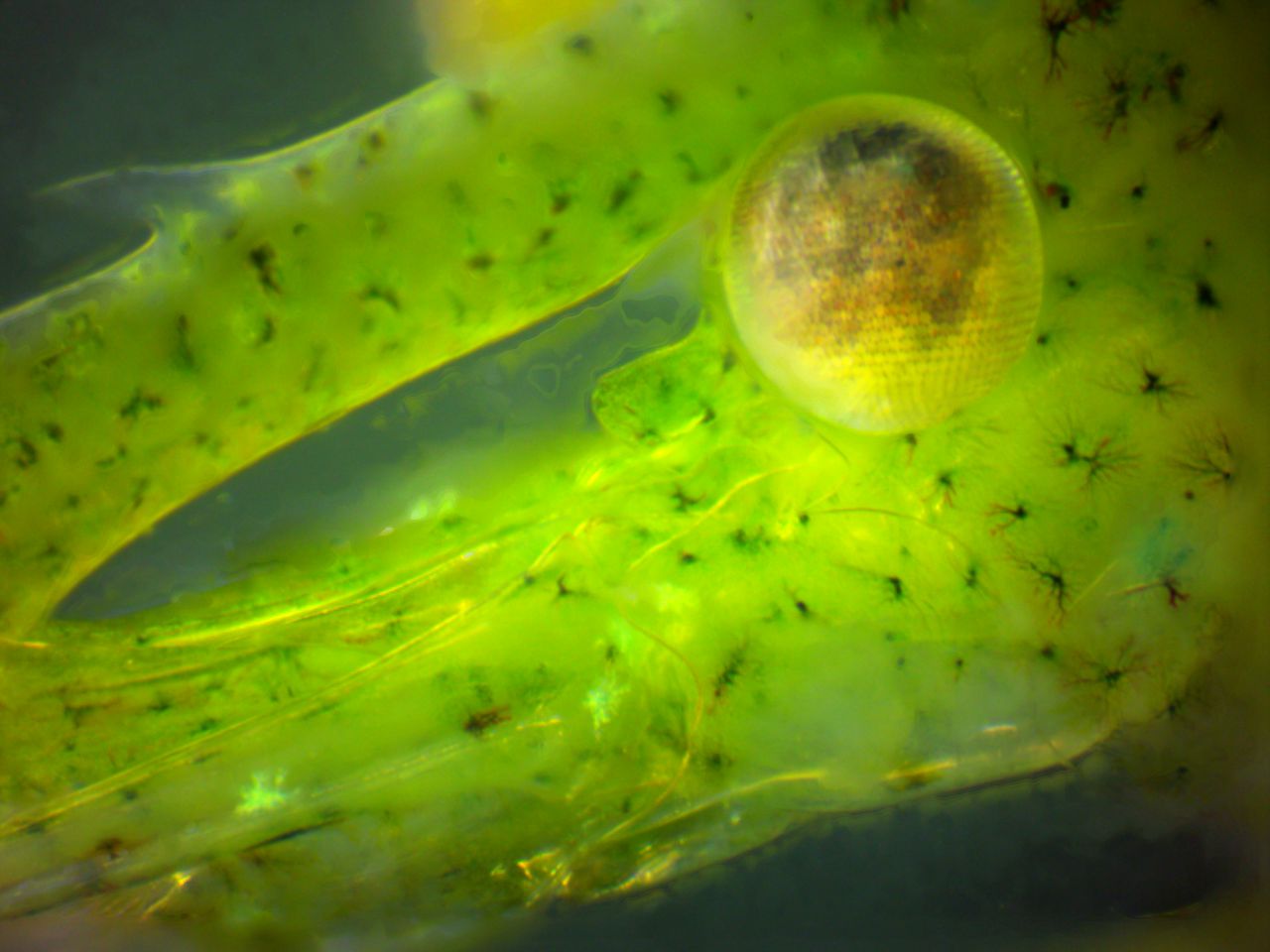
The eye appears golden (or pink according to some
references).
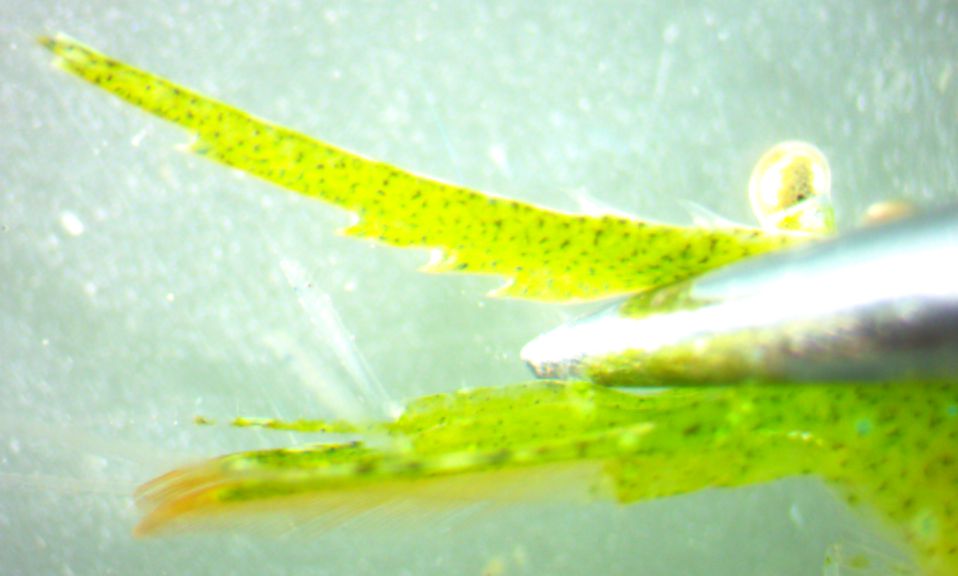
The rostrum
of this individual has 2 dorsal
and 4 ventral
teeth.
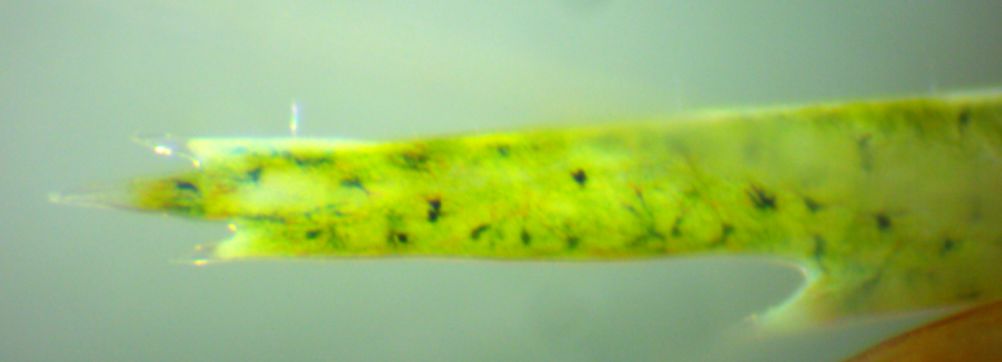
The tip of the rostrum
is trifid
(ends in 3 points)
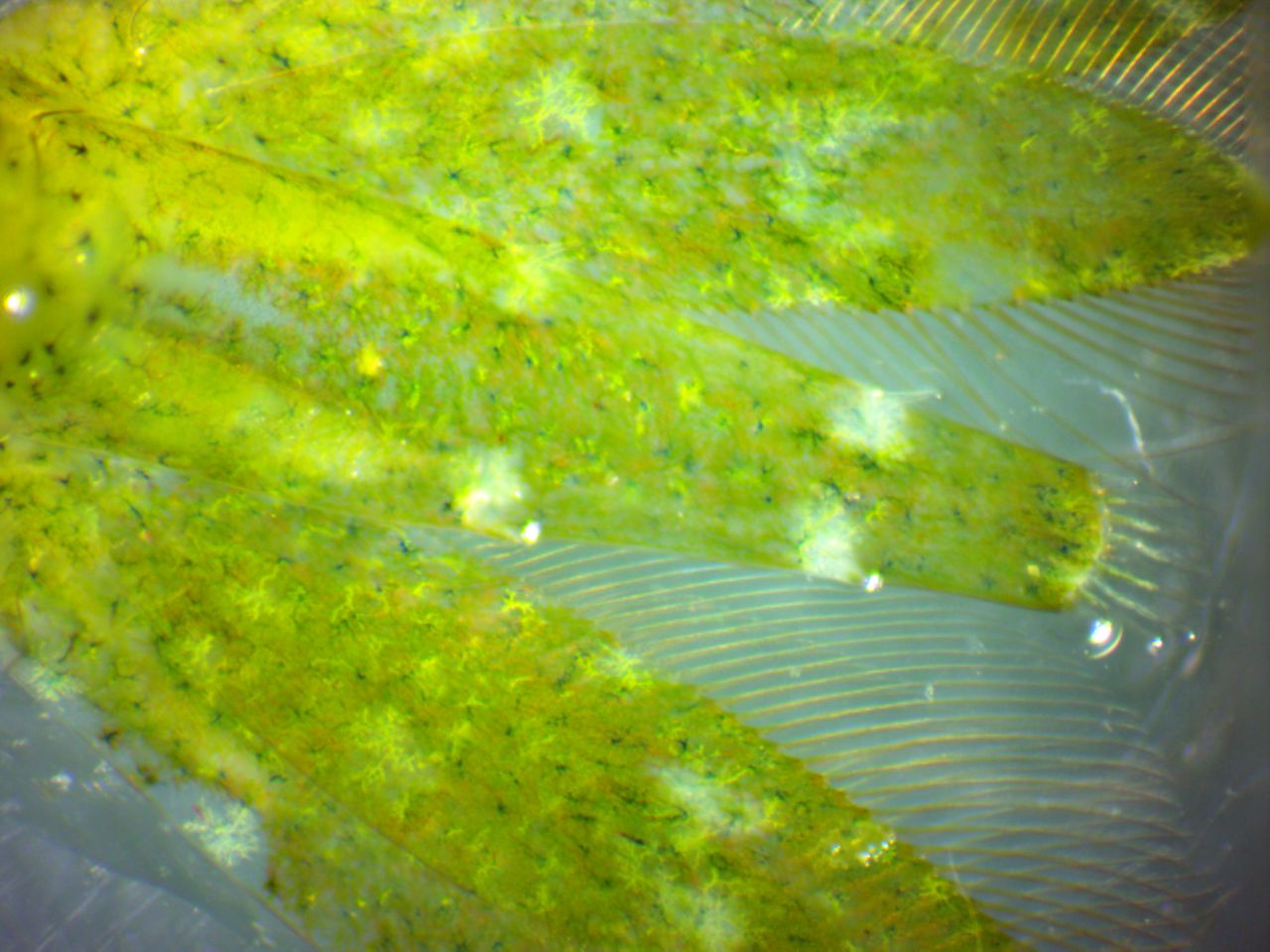
The telson
has two pairs of dorsolateral
spines, seen here in the lighter patches.
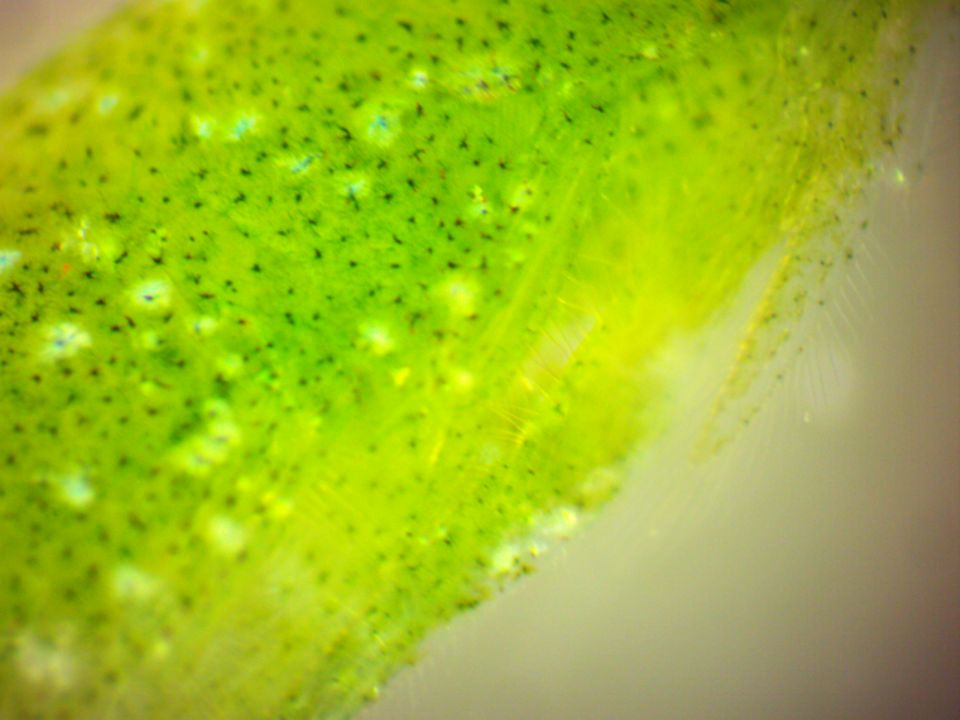
Another view of the coloration: Green background with many small dark
spots and fewer, larger blue spots
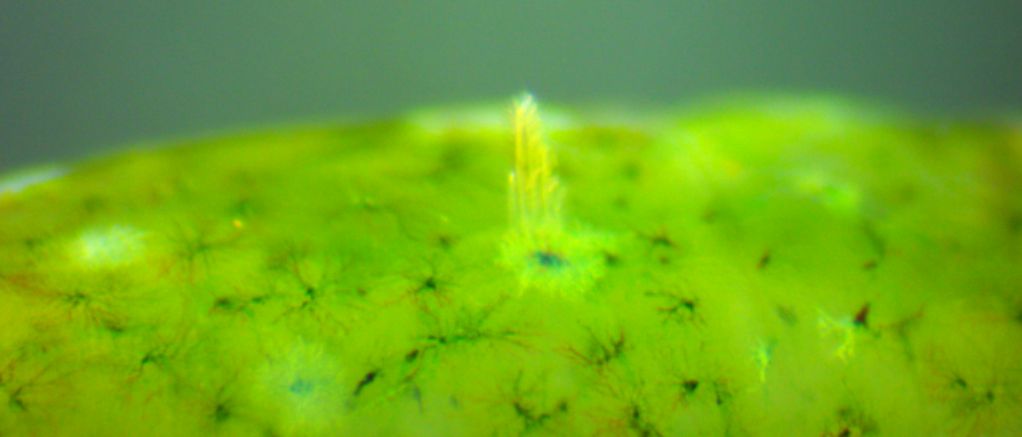
This individual had several odd tufts projecting from the dorsal
exoskeleton on the abdominal
segments. The tufts were pinnate
(feather-shaped), usually were in clusters, and appeared to be based on
a blue-colored spot like this one. The coloration of the exoskeleton
where
they erupted seemed to be disrupted more than usual. I don't know if
this
is normal or some pathological condition. Photo by Dave Cowles, August
2018

This female is carrying eggs in August 2018.
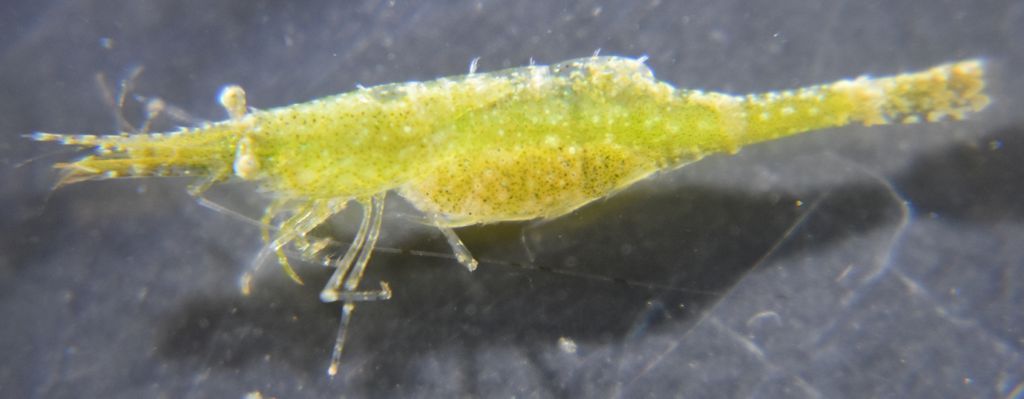
Another gravid
female in August 2018. Note the strong curvature on the 3rd segment of
the abdomen
that gives the Family Hippolytidae the name 'broken-back shrimp'.
A second potential species: Hippolyte californiensis?
The earlier references (Kozloff 1987, 1996; Butler 1980) and some more recent ones (Wicksten 2009; Jensen 2014) list Hippolyte clarki as the only species of Hippolyte in our area. Another species, Hippolyte californiensis, the California green shrimp, has a range from California south (Morris et al., 1980, Wicksten 2009). These references state that specimens identified as H. californiensis found north of California are probably actually H. clarki. However, some recent references (Jensen 1995; Lamb and Hanby 2005) report that the range of H. californiensis extends all the way up to Alaska. The two species are said to be extremely similar to one another. The main difference cited is that the rostrum of one species ends with two points and the rostrum of the other ends with three points. To confuse things, different references assign different characters to the two species. Carlton (2007), Wicksten (2009), and Jensen (1995) state that the rostrum of H. clarki ends in 3 points while that of H. californiensis ends with 2, while Lamb and Hanby (2005) state that H. clarki ends with 2 points and H. californiensis with three. Jensen (2014) states that the rostrum of H. clarki ends in 3 points while that of H. californiensis usually ends in 2. In addition, the color of H. clarki is usually described as being a mostly uniform color (usually green) while H. californiensis may be green or mottled or striped with tan or brown. Total length of H. californiensis is up to 4 cm; somewhat longer than H. clarki. Below are some photos of another gravid female shrimp captured from subtidal eelgrass in Padilla Bay which has some features like H. californiensis (and some odd features of its own) but does have a trifid rostrum. It is likely H. clarki but may be H. californiensis. The carapace length is 7 mm and the total length (including rostrum) is 3.3 cm.
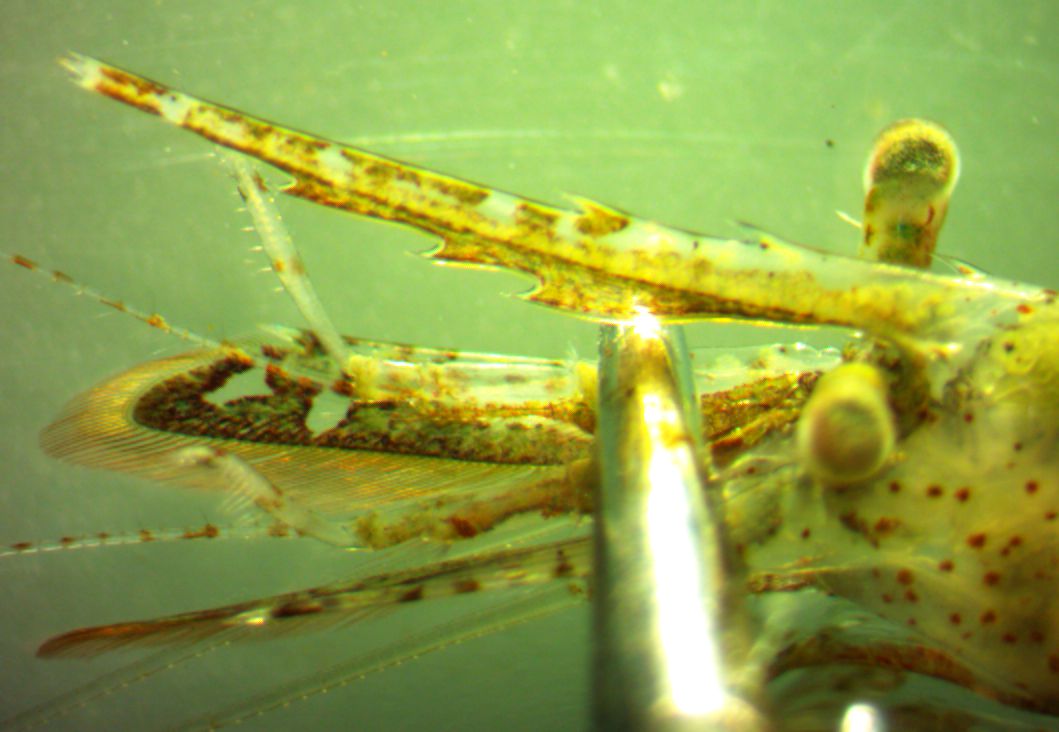
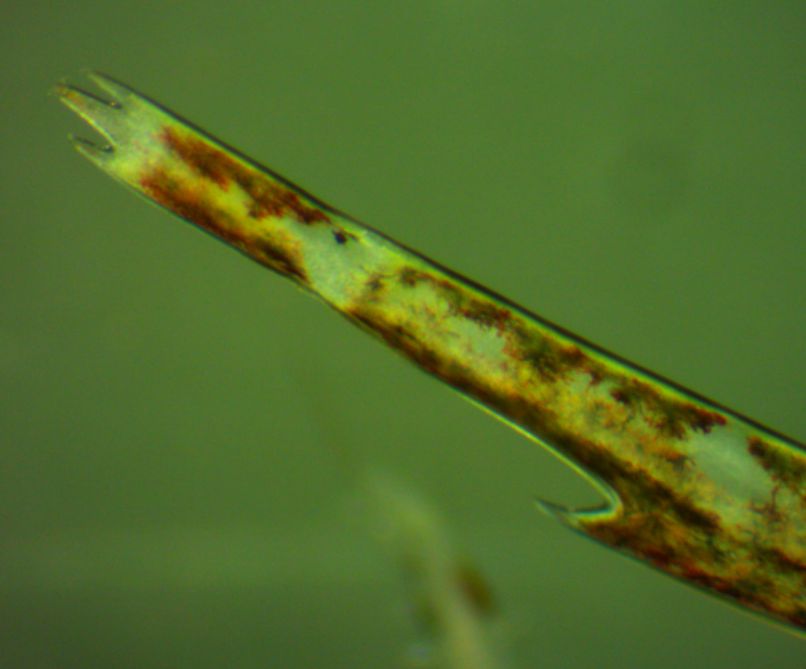
The tip of the rostrum
is definitely trifid
(ends in 3 points).
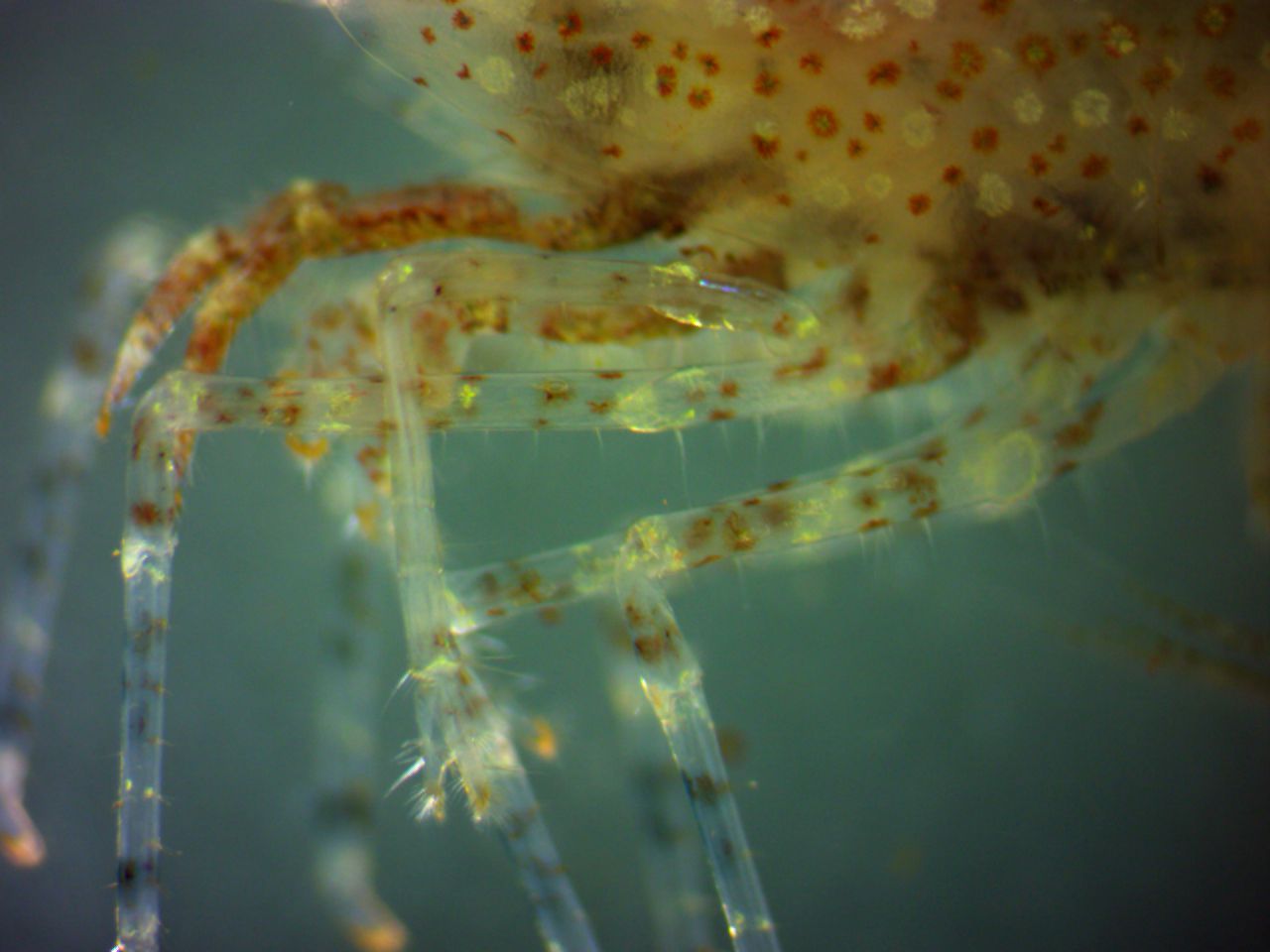
This image shows the carpus
of the pereopods
on the left side. The carpus
is the descending section. Farthest to the left is pereopod
3, next (draped over it) is pereopod
2 showing the 3 multiarticulated subsections, next is pereopod
4, and last on the right is pereopod
5.
| This individual has even more odd pinnate tufts from the exoskeleton than the individual above had. | |
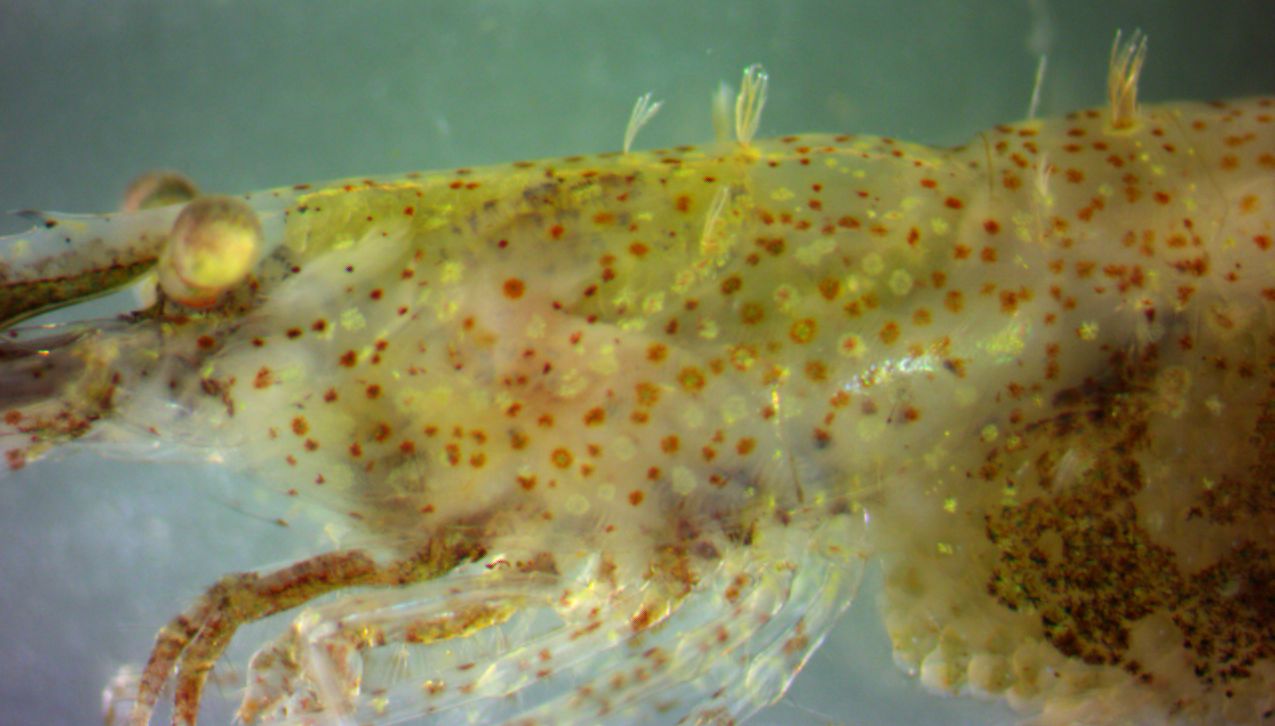 |
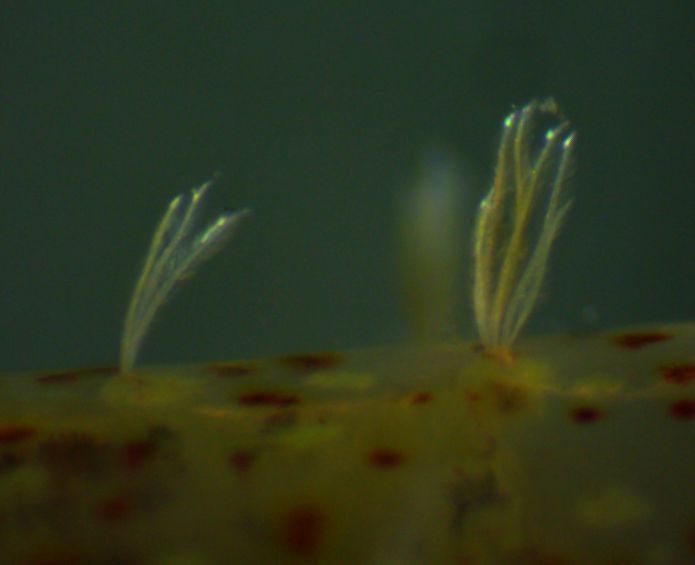 |
| Some tufts are on the dorsal thorax | Closeup of a cluster of dorsal thoracic tufts |
 |
 |
| Even more are on the dorsal abdomen | Closeup of a cluster of dorsal abdominal tufts |
Authors and Editors of Page:
Dave Cowles (2018): Created original page
CSS coding for page developed by Jonathan Cowles
Salish Sea Invertebrates web site provided courtesy of Walla
Walla University
